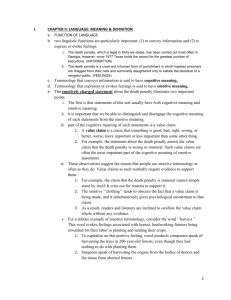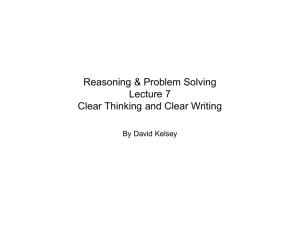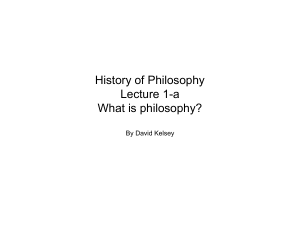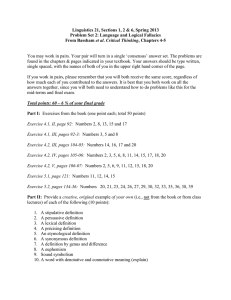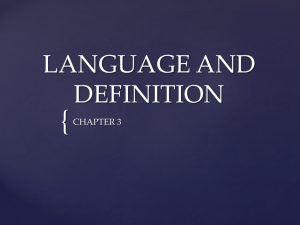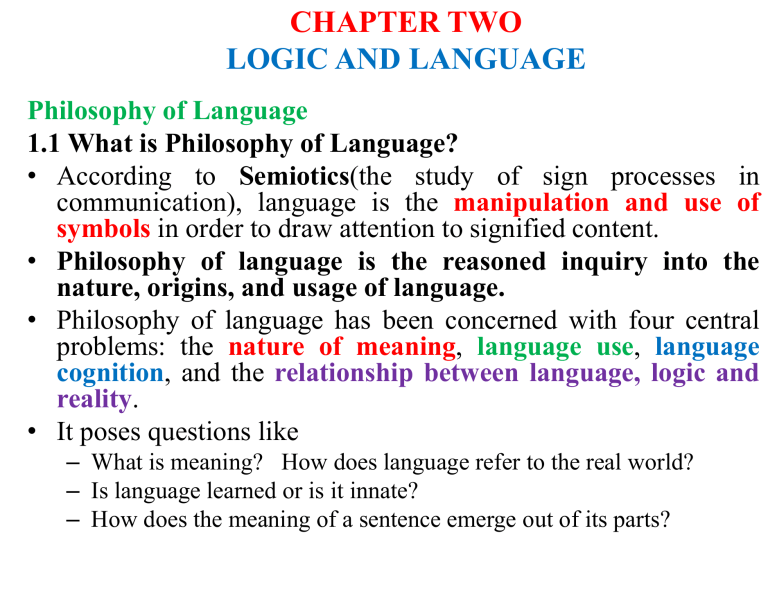
CHAPTER TWO LOGIC AND LANGUAGE Philosophy of Language 1.1 What is Philosophy of Language? • According to Semiotics(the study of sign processes in communication), language is the manipulation and use of symbols in order to draw attention to signified content. • Philosophy of language is the reasoned inquiry into the nature, origins, and usage of language. • Philosophy of language has been concerned with four central problems: the nature of meaning, language use, language cognition, and the relationship between language, logic and reality. • It poses questions like – What is meaning? How does language refer to the real world? – Is language learned or is it innate? – How does the meaning of a sentence emerge out of its parts? Philosophy of language, however, should not be confused with Linguistics, because Linguistics is the field of study that asks questions like: What distinguishes one particular language from another e.g. what is it that makes "English" English? What is the difference between Spanish and French?. Linguists, like Noam Chomsky, a figure who has come to define the 20th century linguistics, have emphasized the role of "grammar" and syntax (the rules that govern the structure of sentences) as a characteristic of any language. Chomsky believes that humans are born with an innate understanding of what he calls "universal grammar" (an innate set of linguistic principles shared by all humans) and a child's exposure to a particular language just triggers this antecedent knowledge. Ordinary language serves various functions in our day-to-day life. These functions are almost unlimited. Thus, among other things, individuals use language: To tell stories, to ask questions, to guess at answers, to form hypotheses, to launch verbal assaults, to tell jokes, to give directions, to sing songs, to issue commands and to greet someone and so on. 1.2 A Brief Note on the Debates and History of Philosophy of Language 1.3 Some Philosophical Approaches to the Nature of Meaning Arguably, there are two essentially different types of linguistic meaning: conceptual meaning (which refers to the definitions of words themselves, and the features of those definitions, which can be treated using semantic feature analysis) and associative meaning (which refers to the individual mental understandings of the speaker, and which may be connotative, collocative, social, affective, reflected or thematic). There are several approaches to the philosophical nature of meaning. Among others, the following are the major ones: 1) Idea theories: these theories claim that meanings are purely mental contents provoked by signs. 2) Truth-conditional theories: these theories hold meaning to be the conditions under which an expression may be true or false. 3) Use theories: these theories understand meaning to involve or be related to speech acts and particular utterances, not the expressions themselves. 4) Reference theories (or semantic externalism): these theories view meaning to be equivalent to those things in the world that are actually connected to signs. 5) Verificationist theories: these theories associate the meaning of a sentence with its method of verification or falsification. T 6) Pragmatist theories: these theories maintain that the meaning or understanding of a sentence is determined by the consequences of its application? Lesson 2: Logic and Meaning 2.1 The Functions of Language: Cognitive and Emotive Meaning Of these functions of language, the cognitive function of language is a relevant and an important for logic In general, language has three linguistic functions namely, expressive (emotive), directive and cognitive (informative) function. A. Expressive (Emotive) Function It is a function of language which is important for individuals to express their feelings or emotions. Both positive and negative feelings. examples She is smart I like my English teacher I hate him. I dislike Abebe. B. Directive Function It gives direction to the speaker or writer in order to pass orders, commands or instructions to others. Examples: What is your name? Leave me alone! Do not close that door! Give me your pen! C. Cognitive (Informative) Function It used to convey information about the world’s objective realities. For Example: Ethiopia has its own prestigious airlines. (True) The capital city of the regional state of Afar is Hawassa. (False) Lake Tana is found in Amhara region. (True) The reason why we study about definitions is words have meanings. Meanings are conveyed through definitions Some times the meaning of certain words in the argument is vague or ambiguous. On the other hand logic evaluates arguments, and an argument consists of a group of statements, and statements are made up of words. Meaning of term Term is any word or arrangement of words that may serve as the subject of a statement. Terms consist of proper names, common names, and descriptive phrases. Proper Names Common Names Descriptive Phrases • Ayele house The first president of Ethiopia • John Person The king of England • South Ethiopia Animal Those who study hard Words that are not terms include verbs, nonsubstantive adjectives, adverbs, prepositions, conjunctions, and all non-syntactic arrangements of words. Examples dictatorial, run quickly, above and beyond, moreover, craves, cabbages, into again, the forest. The Intension and Extension meaning of Terms The intentional meaning, is also known as connotation, refers to the qualities or attributes that the term connotes. The extensional meaning, is also called denotation, consists of the members of the class that the term denotes. Examples: “Inventor” means a person who is, clever, intuitive, creative and imaginative. “Inventor” means such as Thomas Edison, Alexander Graham Bell, and Samuel F.B. Morse. The meaning of the first example is based on its attributes, qualities or essential characteristics. The meaning of the second example is based on its class members. This is because this sentence provides lists of individuals who are the member of the class of the term being defined - inventor The denotation of a term remains the same from person to person. For example, The denotation (extensional meaning) of human being refers to all human being in the universe, on which everybody agrees. This term either constantly fluctuating as some human beings die and others are born or it is presumably constant because it denotes all human beings, past, present, or future. Denotation of a term doesn’t remain the same from time to time? For example, ‘the current king of Ethiopia. Is there any king in Ethiopia now? No. Therefore, this term denotes an empty extension. An empty extension is said to denote: the empty or “null” class - the class that has no members. You may recognize from the above example that emperor Haile Sillasie was the king of Ethiopia in the past. Therefore, ‘the current king of Ethiopia’, changed over the passage of time. Thereby, things that do not have current objective reference include myth, spiritual realities, extinct (died out) creatures, historical events, and so on do not have extension. For instance, Dinosaur, Dragon, Satan, fictional and mythical stories, etc. They do not have objective references that could serve as a living testimony for their existence. Our knowledge of these things is based on their properties and but not based on their living class members’ characteristics. However, the intentional meaning of a term serves as the criteria for deciding what the extension consists of. That is why intentional meaning determines extensional meaning. Example: Satan is an evil sprit that causes people to suffer. Dinosaur is an extinct reptile of the Mesozoic era. Terms may be put in the order of depending on the increase or decrease of attributes and sets of things added to the term being defined. Increasing intension, increasing extension, decreasing intension, and decreasing extension If the member of a class of things decrease, then the attribute of particular objects increase. The order of decreasing intension is the reverse of that of increasing intension but not always. If the member of a class size gets larger with each consecutive term, then the attribute of the particular object decreases. Decreasing extension is the reverse of this order. Example: – Increasing Intension: Africa, East Africa, Ethiopia, Addis Ababa. – Decreasing Intension: Addis Ababa, Ethiopia, East Africa, Africa. – Increasing Extension: Addis Ababa, Ethiopia, East Africa, Africa. – Decreasing Extension: Africa, East Africa, Ethiopia, Addis Ababa. • Definitions and Their Purposes Many logicians define the term ‘definition’ as a group of words that assigns a meaning to some words or group of words. Accordingly, every definition consists of two parts: the definiendum and the definiens. The Latin term definiendum is the word or group of words that is supposed to be defined, and the Latin term definiens is the word or group of words that does the defining or gives a meaning to the definiendum. • Example: diffident means lacking confidence in oneself. In this definition, the term ‘‘diffident’’ is the definiendum, and everything that comes the word “means” (lacking confidence in oneself; characterized by modest reserve) is the definiens. • The most important objective of definition is to provide meaning for the terms that are not clearly understood in the context of other terms. • Purposes of Definitions in logic Definition helps us To avoid confusion or misleading use of words and phrases; To avoid obscurity(insignificance),unintelligibility(un clearness), subjectivity(bias) , and complexity of words; To introduce new words and to persuade(ecourage) others; To avoid useless controversies, disputes, disagreements and conflicts over the meaning of terms ,words, phrases and passages which considered as an argument; To prevent incorrect reasoning; and to develop the ability to reason logically. There are five different types of definitions, namely, Stipulative, Lexical, Précising, Theoretical, and Persuasive Definitions. A. Stipulative Definition Stipulative definition assigns a meaning to a word for the first time. This may involve either creating a new word or giving a new meaning to an old word. The purpose of a stipulative definition is to introduce unusual or unfamiliar words, which have no pervious meaning in the language. Stipulative definition is used to introduce new meanings to some newly discovered phenomenon or things in the area of archeological findings, and innovations, such as new modes of behaviors, new kinds of fashion clothes, new dances, new food inventions, etc • Example: A few years ago the attempt was made at a certain zoo to crossbreed male tiger and female lion by biologists. As a result of this, the offspring was born from male Tiger and female lion. Thus, this suggests a need for assigning a new name. So, they may call the new offspring ‘‘Tigon’’ taking the first three letters from tiger (tig) and the last two letters from lion (on). Another use of stipulative definitions is to set up Secret Codes. It was (and still is) common to give a secret code for the military invasion. • Examples: ‘‘Operation Barbarosa’’ was the name the code Germans gave to the invasion of Russia; ‘‘Operation Desert Storm’’ was the code name given to the military invasion of Iraq. “Operation Sun Set” was the code name given to the military victory of Ethiopia armed force against Eritrea, which is the most recently. B. Lexical Definition A lexical definition is used to report the meaning that a word already has in a language. Dictionary definitions are all the best examples of lexical definitions. The purpose of a lexical definition is to eliminate ambiguity that would arise over the improper use of word to its context. A word is ambiguous if it has more than one meaning. Some words that are subjected to ambiguous usage are: “light”, “bank”, “sound”, “right” , “race”, ‘‘mad’’, “defuse” , “humanity” ,etc. Examples: ‘‘Light,’’ can mean light in weight or radiant energy. ‘‘Bank’’ can mean a finical institution or the edge of river. A word is vague If it is so imprecise and unclear, that is, it is impossible to tell about the applicability of the word. If it is impossible to tell whether the word applies to them or not. Words such as “love”, ”happiness”, “peace”, “fresh”, “normal”, “rich”, ”poor”, “polluted” etc are vague words. It is difficult to draw a line or a boundary between the things to which those words apply or do not apply. We can not tell with any degree of precision who rich is or how we counted as rich. C. Précising Definition A précising definition provides a more precise, specific, exact and restricting meaning to a term. Its use is to reduce vagueness of the term. For example, the word ‘poor’ is a vague word. Suppose you are an administrator of one humanitarian organization and want to give a direct financial assistance to the poor. Therefore, we may define Poor as: “Poor” means a person having a monthly income of less than Birr 150 . This is an example of a précising definition. Précising definition used to clarify a highly systematic context such as science, mathematics, medicine or law. Examples:‘‘force’’, ‘‘energy’’, ‘‘acid’’, ‘‘element’’, ‘‘number” “equality’’, ‘‘contract’’, and ‘‘agent’’ A précising definition differs from a stipulative definition in that Stipulative definition involves a purely arbitrary assignment of meaning The assignment of meaning in a précising definition is not at all arbitrary. Care must be taken that the meaning in a précising definition is appropriate and legitimate for the context within which the term is to be employed. • D. Theoretical Definition A theoretical definition assigns a meaning to a word by suggesting a theory that gives a certain characterization to the entities that the term denotes. In other words, it gives us the way of seeing or conceiving (imagining) theoretical (that is, nonexperimental or non- practical) entity. Fore example there is no any way to see or view “heat” except in theoretical way. Not all theoretical definitions are associated with science. Many terms in philosophy, such as ‘‘substance’’, ‘‘form’’, ‘‘cause’’, ‘‘change’’, ‘‘idea’’, ‘‘good’’, and ‘‘mind’’, have been given theoretical definitions. • Most of the major philosophers in history have given these terms their own peculiar theoretical definitions, examples: ‘‘Good’’ means the greatest happiness of the greatest number provided the underpinnings for his utilitarian theory of ethics. “Substance” means something that up supports different qualities. “Justice” means to give each individual what he or she deserves his or her due. • E. Persuasive Definition The purpose of Persuasive definition is: persuading or convincing listeners or readers over a certain issue; changing or influencing the attitude of others towards one’s own point of view and to win the acceptance of audience. The method employed to develop persuasive definition is to use emotionally charged or value laden words and phrases for the purpose of inciting, striving or arousing the emotion of audiences to make them to accept the definition. This definition may exaggerate or diminish the definiendum. Here are some examples of opposing pairs of persuasive definitions: ‘‘Abortion’’ means the ruthless murdering of innocent human beings. ‘‘Abortion’’ means a safe and established surgical procedure whereby a woman is relieved of an unwanted burden. Techniques of Definition and Their Relation with Kinds of Definitions 1. Techniques of Extension (Denotative) Definitions Extensional definitions provide meaning to a term by listing examples to the term which is being defined definiendum. It is indicating the members of the class There are at least three ways of indicating the members of a class: by pointing physically to them, by naming them individually, and by naming them in groups. Thus, based on this we identify three different kinds of definitions, namely, demonstrative or ostensive definitions, enumerative definitions, and definition by subclass respectively • Demonstrative (Ostensive) Definition It assigns a meaning to a term by pointing physically to the thing or object to be defined. It is probably the most primitive form of definition. This definition might be either partial in a sense that when we point to only some part of things or complete Therefore, ostensive definition attempts to define a term by showing the object physically. • Examples: ‘‘Chair’’ means this and this and this—as you point to a number of chairs, one after the other. ‘‘House’’ means this one—using a picture demonstrating a house. Demonstrative definitions differ from the other kinds of definitions in that the definiens is constituted at least in part by a gesture—the gesture of pointing. Since the definiens in any definition is a group of words, however, a gesture, such as pointing, must count as a word. While this conclusion may appear strange at first, it is supported by the fact that the ‘‘words’’ in many sign languages consist exclusively of gestures. • Enumerative Definition It the members of the class that the definiendum denotes individually. It assigns a meaning to a term by naming individually the members of the class the term denotes. Like demonstrative definitions, they may also be either partial or complete. It is carried out through listing some or all of the objects or entities symbolized by the definiendum. Examples: ‘‘Actor’’ means a person such as Nick Nolte, Al Pacino, or Richard Gere. “Athlete” means a person such as Hail G/sillassie, Kenensia Bekele, Derartu Tulu, etc. Definition by Subclass A definition by subclass assigns a meaning to a term by naming subclasses of the class denoted by the term. Definition by subclass assigns a meaning to a term by naming either partial or complete. • Examples: ‘‘Tree’’ means an oak, pine, elm, spruce, maple, and the like. ‘‘Flower’’ means a rose, lily, daisy, geranium, zinnia, and the like. “Professional person” means a person such as a doctor, or an architect. 2. Techniques of Intentional (Connotative) Definitions Intentional or connotative definition provides a meaning to a term by describing the essential characteristics or features possessed by the term being defined. Kinds of intentional definitions includes: Synonymous Definition, Etymological Definition, Operational Definition, and Definition by Genus and Difference. • A. Synonymous Definition • A synonymous definition is one in which The definiens is a single word that connotes the same attributes as the definiendum. The definiens connotes exactly the same attributes as the definiendum. • Examples: ‘‘Physician’’ means doctor. ‘‘Intentional” means willful. ‘‘Observe’’ means see. Therefore, we can interchangeably use the definiens and the definiendum of synonymous definitions. B. Etymological Definition An etymological definition assigns a meaning to a word by revealing the word’s root or ancestry in both its own language and other languages. That is why most ordinary English words have ancestors either in Old or Middle English as well as are derived or come from some other language such as Greek, Latin, or French, etc. • Examples: The word “Democracy” is derived from the two Greek words, ’demos’ and ‘crates’, which means people and power respectively. The English word ‘‘License’’ is derived from the Latin verb licere, which means to be permitted, and The English word ‘‘Captain’’ derives from the Latin noun caput which means head. C. Operational Definition It assigns a meaning to a word by specifying certain experimental procedures and it is carried out by performing the actions, operations, activities and procedures that the word implies . It can be identified by words “if and only if” which is equivalent to ‘necessary and sufficient condition.’ • Examples: One substance is ‘‘Harder than’’ another if and only if one scratches the other when the two are rubbed together. A solution is an ‘‘Acid’’ if and only if litmus paper turns red when dipped into it. D. Definition by Genus and Difference It assigns a meaning to a term by identifying two things: one ‘genus’ term and one or more ‘difference’ words. In logic, ‘‘genus’’ means a relatively larger class, and ‘‘species’’ means a relatively smaller subclass or smaller of the genus. For instance, if you may speak ‘animal’ as a genus, and ‘mammal’ as species or if you take ‘mammal’ as genus and ‘feline’ can be species. Again, if you take ‘feline’ as genus, ‘tiger’ (which is the subclass of the class of cat family), can be the species. Where as the ‘‘specific difference,’’ or ‘‘difference” is the attribute or attributes that distinguish the various species within a genus. For example, the specific difference that distinguishes tigers from other species in the genus feline (a cat family) would include the attributes of being large, striped, ferocious (aggressive), and so on. Therefore, these aforementioned qualities of tiger are called the ‘specific difference’ or simply ‘difference’ of tiger. When the genus is qualified, we get the ‘species’ (that is, the word to be defined). A definition by genus and difference is easy to construct. The step is Simply select a term that is more general than the term to be defined, and then narrow it down so that it means the same thing as the term being defined. Example • • • • Species Ice Husband Mother Tiger Difference means means means means Genus frozen water. married man. female parent a large, stripped and ferocious feline Lexical definitions are typically definitions by genus and difference, but they also often include etymological definitions. Operational definition can serve as the method for constructing stipulative, lexical, précising, and persuasive definitions, but it could not be used to produce a complete lexical definition. Synonymous definition may be used to produce only lexical definitions. Synonymous definition cannot be used to produce stipulative definitions because the definiendum must have a meaning before a synonymous definition. Also Synonymous can not be used to construct précising, theoretical, and persuasive definitions because the definiens of synonymous definitions contains no more information than the definiendum. In other words, the definiens of a synonymous definition adds nothing new to the definiendum. • Criteria for Lexical Definitions Rule1:A Lexical definition should match to the standards of proper grammar. A definition should be grammatically correct. Definitions that are grammatically incorrect create disagreements and disputes among individuals over the meaning of terms. Examples: Consider the following definitions that are grammatically incorrect are as follows: Vacation is when you don’t have to go to work or school. Furious means if you’re angry at someone. The corrected versions are: ‘‘Vacation’’ means a period during which activity is suspended from work or school. ‘‘Furious’’ means a condition of being angry. Rule 2:A lexical definition should convey or communicate the essential meaning or characteristics of the word being defined. Thus, a correct definition attempts to point out the attributes that are essential to the designation of things as the members of the relevant group. Example: ‘‘Human being’’ means a featherless biped. This definition fails to says nothing about the important attributes that distinguish human beings from the other. A correct and adequate definition would be “Human being” means “the rational animal that has the capacity to reason and to speak” and not as a featherless biped. • Rule 3: A lexical definition should be neither too broad nor narrow. If a definition is too broad, the definiens includes too much; if it is too narrow, the definiens includes too little. In other words, a good or correct definition should be proportionate, that is, the extent of the defining word (definiens) should be equal to the extent of word to be defined (definiendum), A definition is too broad if the definiens applies to things to which the definiendum does not. In a too broad definition, the definiendum is less than the definiens. A definition is too narrow if the definiendum applies to things to which the definiens does not. In a too narrow definition the definiendum is greater than the definiens. Examples: The following definitions are broad ‘‘Birds’’ means any warm-blooded animals having wings. “Pen” means an instrument used for writing. In the first example, the phrase “any warm-blooded animal having wings” would include bats, and bats are not birds. In the second example, the phrase “an instrument used for writing “ includes things like chalk, pencil, marker, pen, etc. Examples: The following definitions are narrow ‘‘Bird’’ means warm-blooded, feathered animal that can fly. “Gun” means a tool used in the battle for defending the enemy. These two definitions would be too narrow. The first definition would exclude ostriches, which cannot fly. In the second definition the term gun is defined using a few attributes, that is, the definiens fails it include different attribute of gun. • Rule 4: A lexical definition should avoid circularity A circular definition presents the meaning of a word: either by using the same word with the same meaning in the definiens, or by using grammatical variation of the same word (the definiendum) in the definiens. Examples: ‘‘Religious ’’ means any one engaged in religious activity. ‘‘Scientist’’ means anyone who engages in science. A circular definition cannot provide any useful additional information to the word being defined or their definiendum becomes visible in the Rule 5: A lexical definition should not be negative when it can be affirmative. Of the following two definitions, the first one negative, and the second affirmative: Example ‘‘Concord’’ means the absence of discord. “Concord’’ means harmony. Thus, definition should explain what a term does mean rather than what it does not mean. Some words, however, are intrinsically negative. For them, a negative definition is quite appropriate. Example ‘‘Bald’’ means lacking hair. ‘‘Darkness’’ means the absence of light. “Death” means the end of life • Rule6:A lexical definition should not be expressed in figurative, obscure, vague, or ambiguous language. A definition is figurative when it involves and based on metaphors. A metaphor is a word or a phrase used in the imaginative way. A definition is figurative when it also tends to paint a picture (describes the thing in a particular way) instead of exposing the essential meaning of a term. Example1: If you define ‘architecture’ as frozen music, you are expressing it in figurative language. Example 2: If you define ‘camel’ as ship of the desert you are also expressing it in figurative language. A definition is Obscure if its meaning is hidden as a result of defective or inappropriate language or expression. One source of obscurity is excessively technical language. Examples ‘‘Bunny’’ means a mammalian of the family Leporidae of the order Lagomorpha whose young are born furless and blind. ‘‘Bunny’’ means a rabbit. The problem lies not with technical language as such but with needlessly technical language. Because ‘‘bunny’’ is very much a no technical term, no technical definition is needed. A definition is vague if it lacks precision or if its meaning is unclear—that is, if there is no way of telling exactly what class of things the definiens refers to. • Example: ‘‘Democracy’’ means a kind of government where the people are in control. This definition fails to identify the people who are in control, how they exercise their control, and what they are in control of. A definition is ambiguous if it lends itself to more than one different interpretation. • Example: ‘‘Triangle’’ means a figure composed of three straight lines in which all the angles are equal to 1800. Does this mean that each angle separately is equal to 1800 or that the angles taken together are equal to 1800? Rule7:A lexical definition affective terminology. should avoid Affective terminology is an expression that influences others positively or negatively. It includes Sarcastic and facetious (inappropriate) language and any other kind of language that is liable to influence attitudes. Examples: ‘‘Communism’’ means that ‘‘brilliant’’ invention of Karl Marx and other foolish political visionaries. The intended meaning is the opposite of what is meant by brilliant. This is what we call a sarcastic use of language. Dear learner, again look at the following examples: “Ethiopia” is a country of illiterate and hungry people. “Africans” are uncivilized and have no history. Rule 8: A lexical definition should indicate the context to which the definiens pertains. A reference to the context is important definiendum means different meanings in the different context. Examples: ‘‘Strike’’ means (in baseball) a pitch at which a batter swings and misses. ‘‘Strike’’ means (in fishing) a pull and a line made by a fish in taking the bait. In the above definitions at term “strike” has two different meanings in the different contexts given above (baseball and fishing).
